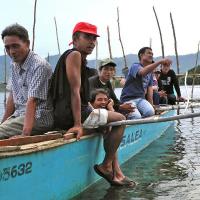October 25, 2017
Worried About Fukushima Radiation in Seafood? Turns Out Bananas Are More Radioactive Than Fish
BY: Allison Guy
Six years ago, a devastating tsunami swept over the eastern edge of Japan, killing over 18,000 people and triggering a nuclear meltdown at the Fukushima Daiichi nuclear power plant. The plant was perched on the coast, so some radiation leaked into the sea. In the months and years following the meltdown, people began to wonder: Did these leaks make Pacific seafood too dangerous eat?
The answer, then and now, is no, scientists say. The Fukushima leaks were miniscule compared to the vast scale of the Pacific, said Nicholas S. Fisher, an expert on nuclear radiation in marine animals at Stony Brook University in New York. The disaster added just a fraction of a percent to the radiation that’s already in the ocean, 99 percent of which is naturally occurring.
At those levels, you could eat piles of Pacific fish and have nothing to worry about from radiation, Fisher said. The dose of Fukushima-derived radiation from the average tuna fillet, he explained, “would be far less than the total radiation you’d get from eating a banana or flying in an airplane.”
CESIUM IN THE SEA
It’s understandable to get the heebie-jeebies from nuclear radiation. “No one can see or touch or feel or smell it,” said Kenneth Buesseler, the director of the Center for Marine and Environmental Radioactivity at Woods Hole Oceanographic Institution in Massachusetts. Most people have a foggy understanding of radioactivity, so real threats get conflated with overblown or made-up ones.
The risks were greatly exaggerated, for example, when several bluefin tuna and one sockeye salmon showed up in the United States and Canada carrying traces of radioactive cesium from Fukushima. Super-sensitive instruments detected the cesium, but the fish weren’t unsafe to eat. “Just because you can detect it,” Fisher said, “doesn’t mean it’s dangerous.”
Even an iota of radiation sounds unsettling, but fish caught in the United States never came close to breaching government safety limits for food. Japan caps radioactive cesium at 100 becquerels per kilogram. The United States limits it to 1,200. Even at their most radioactive, bluefin tuna caught in California waters clocked in at just a sliver of these limits, at around 10 becquerels of radioactive cesium per kilogram of body weight. A year after the disaster, radioactive cesium levels in California tuna had slipped to an average of just 2.7 becquerels per kilo.
Eating a single dish above the U.S. or Japanese cap is no guarantee you’ll get sick, Buesseler said. “You’d have to eat above that limit every day to have what a government considers a significant cancer risk.”
This isn’t to say all fish everywhere had equally trace levels of radioactivity. Tuna caught in Japanese waters after the disaster had around 15 times more radioactive cesium, Fisher said — so, above Japanese government limits, but below U.S. ones. And certain types of seafood caught in and around Fukushima Harbor also exceeded Japan’s radiation cap. The good news is that no Fukushima-caught fish have surpassed safety limits since 2015.
IMAGINARY CANCERS
There’s another reason why fears about nuclear seafood have stuck around for so long. Dozens of health-focused websites, many high up in search engine rankings, spread fake news about the Fukushima meltdown.
One popular site claims to depict salmon afflicted with radiation-triggered “bloody cancerous tumors.” But there’s a catch — none of the “cancers” are what they’re made out to be. One’s actually a bacterial kidney disease. Another is a parasite. The last is a type of oral tumor that has been documented in Chinook salmon for decades before the 2011 tsunami.
Some sites advise their readers to avoid seafood entirely, since any additional radiation exposure boosts cancer risk. But if fish was dangerous, we’d be seeing high rates of cancer among folks who’ve eaten plenty of seafood in the last 70 years. That’s because nuclear testing in the 1950s and 60s released around 100 times more radiation into the ocean than the Fukushima meltdown.
But seafood was, and is, some of the healthiest food around. Eating fish appears to help protect against gastrointestinal and breast cancers, and may improve prostate cancer survival. And the so-called Mediterranean Diet — one where red meat and processed fats are replaced with fish, plants and olive oil — is associated with a range of health benefits, including cancer protection.
A LITTLE BACKGROUND
Food, including seafood, doses us with just a dash of the radiation we receive from other sources, Buesseler said — things as hum-drum as living in brick or stone buildings, flying and getting x-rays. As for the potassium in bananas and in human bodies, about 0.01 percent is naturally radioactive.
Yup, you’re a source of radiation too.
Luckily, all these little doses add up to just a fraction of the amount considered risky. And our bodies are pretty effective at repairing any radiation damage from visiting the doctor’s office or noshing on banana splits. “We live on a radioactive planet in a radioactive universe,” Fisher said. “All life has evolved in the presence of natural radioactivity.”
For Fisher and Buesseler, there was one unsettling finding to emerge from their search for traces of Fukushima in the ocean. They discovered that no U.S. government agency is responsible for testing radioactivity in marine environments. After being rejected by a string of federal offices, both had to turn to private funding for their fish and water tests.
“Even though everybody says it’s an issue, it falls in the cracks between different agencies,” Fisher said. “If the public knew that, they’d probably be unhappy and surprised.”



